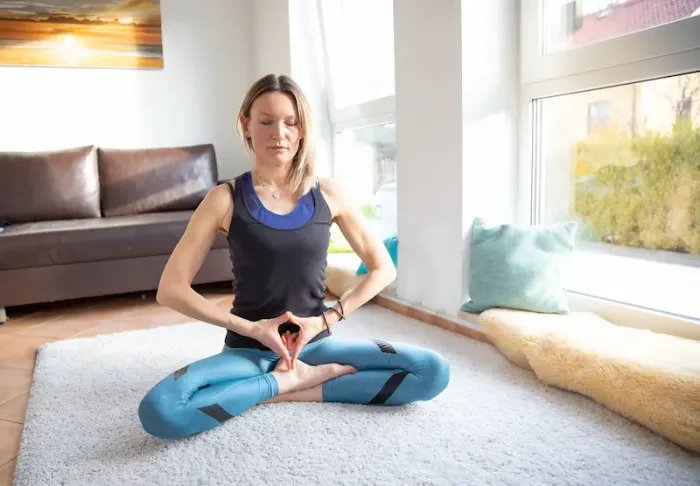Yoni Mudra: Health Benefits and Step-by-Step Practice
Discover yoni mudra benefits. Learn a safe, simple meditation technique that may support relaxation, focus, and women’s health—plus easy, step-by-step instructions.


Introduction
Modern life is busy, and simple practices that calm the mind can make a real difference. Yoni Mudra is a gentle hand gesture used during meditation to encourage quiet focus and steady breathing. While research on Yoni Mudra itself is limited, science does support key elements of the practice—mindful attention and slow, diaphragmatic breathing—for reducing stress and improving well-being. Many people are also curious about yoni mudra benefits for women’s health. This guide explains what Yoni Mudra is, what the evidence suggests it may help with, and how to practice it safely at home.
What Is Yoni Mudra?
Yoni Mudra is a traditional yoga hand gesture. “Yoni” is a Sanskrit word often translated as “womb” or “source,” and the mudra symbolizes turning inward, grounding, and rest. It’s commonly used to support meditation and steady, calm breathing.
There are two common ways people use the term “Yoni Mudra”:
• The hand gesture: Fingers are interlaced to form a shape that resembles the womb. This is typically practiced while seated in meditation.
• A sensory-withdrawal variation: Some traditions teach a technique where you gently reduce sensory input (for example, softening your gaze or lightly closing the ears) to help the mind settle. If you explore this, do it gently and avoid pressing on the eyes.
In this article, you’ll learn the hand gesture plus a safe, optional add-on that pairs well with quiet breathing.
Potential Yoni Mudra Benefits: What the Science Suggests?
There are few clinical studies on Yoni Mudra as a stand-alone technique. However, its core components—mindfulness, slow breathing, and brief daily practice—are well studied and can be part of a healthy routine. Reputable health organizations note the following potential benefits of meditation and diaphragmatic breathing:
Calmer stress response
• Mindfulness and meditation can help reduce perceived stress and ease anxious feelings for many people.
• Slow, diaphragmatic breathing may activate the body’s relaxation response, helping you feel more at ease.
Improved focus and mood
• Regular meditation supports attention and emotional regulation, helping you feel more centered during the day.
Better sleep support
• Relaxation techniques practiced in the evening may help you unwind and prepare for sleep.
Heart and blood pressure support
• Deep, slow breathing can temporarily lower heart rate and may support healthy blood pressure as part of overall stress management and lifestyle habits. It does not replace medical care.
Important context
• Evidence specifically on “Yoni Mudra” is limited. The benefits listed above reflect research on meditation and diaphragmatic breathing in general.
• Results vary by person. Yoni Mudra should complement—not replace—medical care for any condition.
Yoni Mudra and Women’s Health
• People sometimes ask how Yoni Mudra can support women’s health. While the gesture itself has symbolic meaning related to the womb, its health value likely comes from relaxation and mindful awareness. Here’s how it may fit into a women’s health routine:
Stress management across life stages
• Stress can influence how we experience menstrual symptoms, perimenopause, and menopause. Calming practices like meditation and slow breathing may help you cope more comfortably.
Sleep and mood support
• Consistent relaxation routines can help with winding down at night and navigating mood changes linked with hormonal shifts.
Body awareness
• Gentle mindfulness practices can help you tune into your body with more kindness, which some people find helpful when managing cyclical changes or discomfort.
What it can’t do
Yoni Mudra doesn’t treat conditions like PCOS, endometriosis, fertility challenges, or severe menopausal symptoms. Use it as supportive self-care alongside advice from your healthcare professional.
Consult Top Specialists
Step-by-Step Practice: Yoni Mudra Hand Gesture
Use this simple routine for 5–10 minutes once or twice a day. If you’re new to meditation, even 2–3 minutes is a great start.
1) Set up
• Sit comfortably on a chair or cushion. Keep your spine tall but relaxed.
• Soften your gaze or gently close your eyes if that feels safe.
2) Form the Yoni Mudra
• Bring your hands in front of your lower abdomen.
• Interlace your fingers inward so the backs of your fingers rest against each other.
• Extend both index fingers so they touch each other, pointing downward like an arrow.
• Touch your thumbs together side by side, pointing upward. Your hands form a diamond or womb-like shape.
• Rest the mudra lightly against your lower belly or in your lap.
3) Breathe gently
• Inhale slowly through your nose, letting your belly expand (diaphragmatic breathing).
• Exhale slowly through your nose, letting your belly soften.
• Aim for smooth, comfortable breaths. Many people find a 4–6 second inhale and 4–6 second exhale relaxing, but choose a rhythm that feels easy.
4) Focus your attention
• Pick a simple anchor: the feeling of your hands, the movement of your breath, or the space around your lower abdomen.
• When your mind wanders, kindly bring it back to your anchor without judgment.
5) Close the practice
• After 5–10 minutes, take a fuller inhale, exhale slowly, and open your eyes.
• Notice how you feel before moving on.
Optional Add-On: Gentle Humming Breath
• Humming on the exhale (often called “bee breath”) can enhance relaxation and focus. It pairs well with the Yoni Mudra hand position.
How to try it safely?
• Sit as above with Yoni Mudra formed.
• On each exhale, make a soft “mmmm” sound in your throat or nose, like a gentle hum.
• Keep your jaw loose and lips lightly together.
• Try 5–10 rounds, then breathe normally.
Safety notes
• Avoid pressing on your eyes.
• If you have ear pain, sinus infection, or feel dizzy, skip the humming and breathe naturally.
How Often to Practice for Best Results?
• Start short and regular: 3–5 minutes, once or twice daily.
• Build up gradually: after one to two weeks, increase to 8–10 minutes.
• Use it on-the-go: a minute of calm breathing with the mudra can help before meetings, bedtime, or during a stressful moment.
Safety First: Who Should Modify or Ask a Clinician
Yoni Mudra is generally gentle. Still, keep these tips in mind:
Breathing
• Breathe comfortably. Avoid long breath holds, especially if you’re pregnant or have heart or lung conditions.
• If you feel lightheaded, return to a normal breath or pause the practice.
Eyes and ears
• Do not press on your eyeballs.
• If you have an ear condition or recent surgery, avoid closing the ears or humming if it creates pressure.
Trauma-informed choice
• If closing your eyes feels unsafe, keep a soft, open gaze and focus on a point in front of you.
Medical conditions
• Meditation and breathing practices are supportive, not curative. Follow your clinician’s guidance for any medical condition.
• If you experience persistent symptoms like chest pain, severe headaches, or worsening anxiety or depression, seek medical care promptly.
Practical Tips to Build a Habit
• Tie it to a routine: practice after brushing your teeth or before bed.
• Keep it short and consistent: a little every day beats a long session once a week.
• Use a timer: knowing the session will end can help your mind relax.
• Journal briefly: note how you feel before and after to see patterns over time.
• Be kind to yourself: wandering thoughts are normal. Gently re-focus and continue.Consult Top Specialists
Consult Top Specialists

Dr. Pepsy Jose
Panchakarma Practitioner
14 Years • BAMS, MD Ayurveda (Panchakarma)
Bengaluru
AYURRHYTHM HOLISTIC CLINIC AND PANCHAKARMA THERAPY, Bengaluru

Dr. Anjan Das
Ayurveda Practitioner
8 Years • Ayurvedacharya ( B.A.M.S )
Dumdum
Vedhive Ayurveda Clinic, Dumdum

Dr. Shiv Prakash Singh
Ayurveda Practitioner
19 Years • BAMS
Kolkata
Vedhive Ayurveda College Street, Kolkata

Dr. Rik Sadhukhan
Ayurveda Practitioner
8 Years • BAMS
Kolkata
Vedhive Ayurveda, Ballygunge, Kolkata
Consult Top Specialists

Dr. Pepsy Jose
Panchakarma Practitioner
14 Years • BAMS, MD Ayurveda (Panchakarma)
Bengaluru
AYURRHYTHM HOLISTIC CLINIC AND PANCHAKARMA THERAPY, Bengaluru

Dr. Anjan Das
Ayurveda Practitioner
8 Years • Ayurvedacharya ( B.A.M.S )
Dumdum
Vedhive Ayurveda Clinic, Dumdum

Dr. Shiv Prakash Singh
Ayurveda Practitioner
19 Years • BAMS
Kolkata
Vedhive Ayurveda College Street, Kolkata

Dr. Rik Sadhukhan
Ayurveda Practitioner
8 Years • BAMS
Kolkata
Vedhive Ayurveda, Ballygunge, Kolkata
More articles from General Medical Consultation
Frequently Asked Questions
Q1: What is Yoni Mudra, in simple terms?
It’s a yoga hand gesture used during meditation. You interlace your fingers and touch the thumbs and index fingers to form a diamond-like shape. It’s meant to help you turn inward, breathe calmly, and feel grounded.
Q2: Are there proven yoni mudra benefits?
There’s limited research on Yoni Mudra by itself. However, meditation and slow, diaphragmatic breathing—core parts of the practice—are supported by reputable sources for reducing stress and improving focus, mood, and sleep for many people.
Q3: Can Yoni Mudra help with women’s health issues like PMS or menopause symptoms?
It isn’t a treatment. But by helping you relax and cope with stress, it may make symptoms feel more manageable for some people. Use it alongside medical advice and healthy lifestyle habits.
Q4: Is Yoni Mudra safe during pregnancy?
The gentle, breathing-based version is generally considered low risk. Avoid breath holds and any straining. If you have pregnancy-related concerns or dizziness, stop and speak with your healthcare professional.
Q5: How long should I practice to notice changes?
Many people feel calmer right away. For steadier benefits—like better stress coping—try 5–10 minutes daily for a few weeks. Consistency matters more than session length.



 Benefits and How to Practice It.webp)
